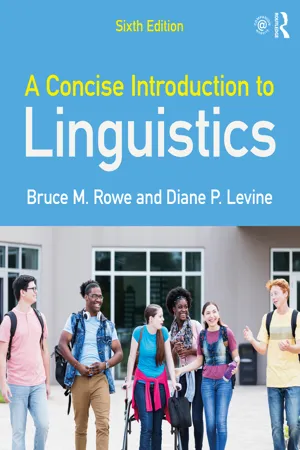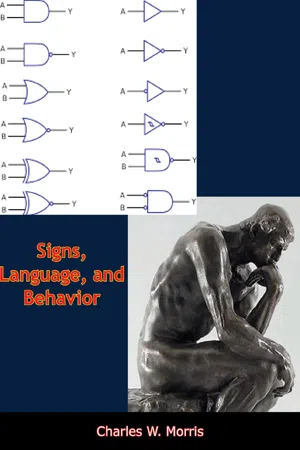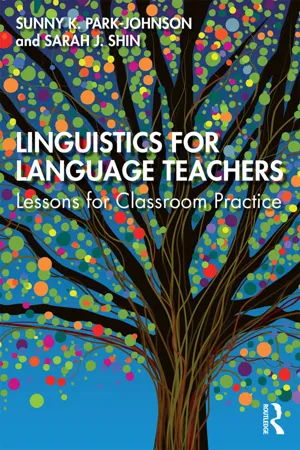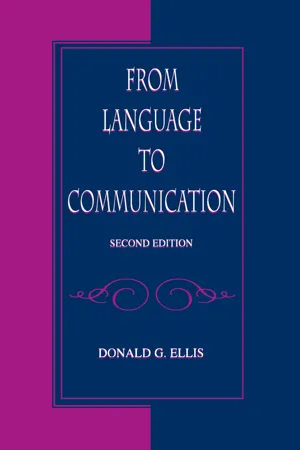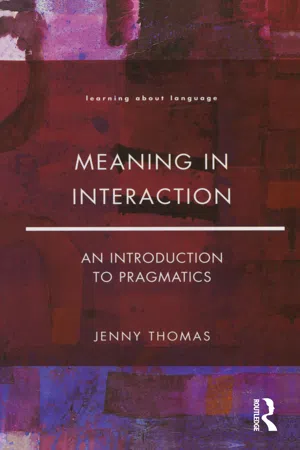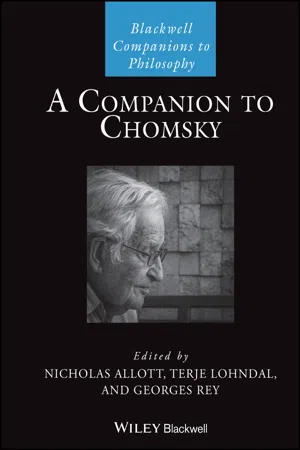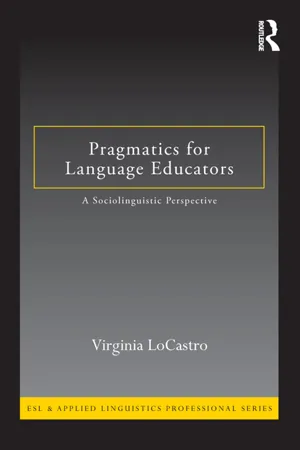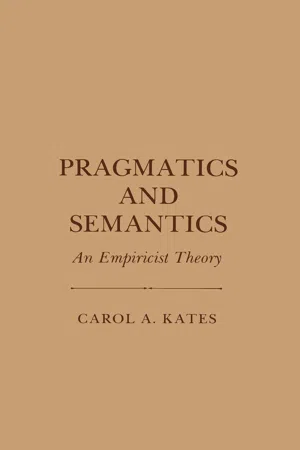Languages & Linguistics
Semantics vs. Pragmatics
Semantics refers to the study of meaning in language, focusing on the literal interpretation of words and sentences. Pragmatics, on the other hand, deals with the study of meaning in context, including how language is used in real-life situations and the effects of context on interpretation. While semantics is concerned with the literal meaning of words, pragmatics explores how language is used to convey meaning in different social and cultural contexts.
Written by Perlego with AI-assistance
Related key terms
Related key terms
1 of 4
Related key terms
1 of 3
11 Key excerpts on "Semantics vs. Pragmatics"
- eBook - ePub
- Betty J. Birner(Author)
- 2012(Publication Date)
- Wiley-Blackwell(Publisher)
This chapter will largely consider the difference between these two types of meaning – the literal meaning and the intended and/or inferred meaning of an utterance. We will begin with preliminary concepts and definitions, in order to develop a shared background and vocabulary for later discussions. A section on methodology will compare the corpus-based methodology favored by much current pragmatics research with the use of introspection, informants, and experimental methods. Then, since no discussion of pragmatics can proceed without a basic understanding of semantics and the proposed theoretical bases for distinguishing between the two fields, the remainder of the chapter will be devoted to sketching the domains of semantics and pragmatics. A discussion of truth tables and truth-conditional semantics will both introduce the logical notation that will be used throughout the text and provide a jumping-off point for later discussions of theories that challenge the truth-conditional approach to the semantics/pragmatics boundary. The discussion of the domain of semantics will be followed by a parallel discussion of the domain of pragmatics, including some of the basic tenets of pragmatic theory, such as discourse model construction and mutual beliefs. The chapter will close with a comparison of two competing models of the semantics/pragmatics boundary and an examination of some phenomena that challenge our understanding of this boundary.1.1 Pragmatics and Natural Language
1.1.1 Introduction and Preliminary Definitions
Linguistics is the scientific study of language, and the study of linguistics typically includes, among other things, the study of our knowledge of sound systems (phonology), word structure (morphology), and sentence structure (syntax). It is also commonly pointed out that there is an important distinction to be made between our competence and our performance . Our competence is our (in principle flawless) knowledge of the rules of our own idiolect – our own individual internalized system of language that has a great deal in common with the idiolects of other speakers in our community but almost certainly is not identical to any of them. (For example, it’s unlikely that any two speakers share the same set of lexical items.) Our performance, on the other hand, is what we actually do linguistically – including all of our hems and haws, false starts, interrupted sentences, and speech errors, as well as our frequently imperfect comprehension: Linguists commonly point to sentences like The horse raced past the barn fell as cases in which our competence allows us – eventually – to recognize the sentence as grammatical (having the same structure as The men injured on the battlefield died ), even though our imperfect performance in this instance initially causes us to mis-parse the sentence. (Such sentences are known as garden-path - eBook - ePub
- Bruce M. Rowe, Diane P. Levine(Authors)
- 2022(Publication Date)
- Routledge(Publisher)
CHAPTER 6 Semantics: the study of meaningDOI: 10.4324/9781003268369-6LEARNING OBJECTIVES- Explain what it means to mean something.
- Explain the basic difference between the related fields of semantics and pragmatics.
- Explain what is meant when we say that a language is a code and a symbol system.
- Define lexical semantics.
- Explain the concept of semantic properties as they relate to words.
- Describe how the components of meaning are analyzed.
- Name words that mean the same or sound the same.
- Name what it is called when rules regarding the meanings of words are broken.
- Explain the difference between lexical and structural semantics.
- Explain the difference between entailment and presupposition and give examples of each.
Semantics within the field of linguistics is the empirical study of the meaning of linguistic expressions, such as morphemes, words, phrases, clauses, and sentences. Elements of nonverbal communication can also be studied for their semantic properties (see Chapter 13 ). Meaning in semantics includes but is not limited to dictionary-type meaning. For instance, if a student talking to a friend says, “I failed the test, great!” great almost certainly does not mean any of the definitions listed in the dictionary. The student is using irony to convey the opposite meaning of the word great. The dictionary meaning of the word is not the same as the speaker’s meaning of the word in this utterance. There are many other ways the dictionary meaning or meanings of a word might not match the speaker, signer, or writer’s meaning of that word. We discuss some of these later in this chapter.Semantics within the field of linguistics is the study of the meaning of linguistic expressions, such as morphemes, words, phrases, clauses, and sentences.Often semantics is narrowly defined as the meaning of expressions divorced from the context in which these utterances are produced, and from various characteristics of the sender or receiver of the message. The study of meaning derived from context and features of the communicators is called pragmatics - eBook - ePub
- Charles W. Morris(Author)
- 2020(Publication Date)
- Barakaldo Books(Publisher)
If we are analyzing a language, then we are concerned, of course, with expressions. But we need not necessarily also deal with speakers and designata. Although these factors are present whenever language is used, we may abstract from one or both of them in what we intend to say about the language in question. Accordingly, we distinguish three fields of investigation of languages. If in an investigation explicit reference is made to the speaker, or, to put it in more general terms, to the user of a language, then we assign it to the field of pragmatics. (Whether in this case reference to designata is made or not makes no difference for this classification.) If we abstract from the user of the language and analyze only the expressions and their designata, we are in the field of semantics. And if, finally, we abstract from the designata also and analyze only the relations between the expressions, we are in (logical) syntax. The whole science of language, consisting of the three parts mentioned, is called semiotic. (Introduction to Semantics , p. 9.)In terms of the approach of the present study, the indicated division of the fields of semiotic needs certain further alterations: the restriction of semiotic to a study of language must be removed, the study of the structure of languages other than the scientific must be made possible, I other modes of signification than the designative must be dealt with in semantics, and this in turn requires some modification of the formulation of pragmatics.The following definitions retain the essential features of the prevailing classification, while freeing it from certain restrictions and ambiguities: pragmatics is that portion of semiotic which deals with the origin, uses, and effects of signs within the behavior in which they occur; semantics deals with the signification of signs in all modes of signifying; syntactics deals with combinations of signs without regard for their specific significations or their relation to the behavior in which they occur.When so conceived, pragmatics, semantics, and syntactics are all interpretable within a behaviorally oriented semiotic, syntactics studying the ways in which signs are combined, semantics studying the signification of signs, and so the interpretant behavior without which there is no signification, pragmatics studying the origin, uses, and effects of signs within the total behavior of the interpreters of signs. The difference lies not in the presence or absence of behavior but in the sector of behavior under consideration. The full account of signs will involve all three considerations. It is legitimate and often convenient to speak of a particular semiotical investigation as falling within pragmatics, semantics, or syntactics. Nevertheless, in general it is more important to keep in mind the field of semiotic as a whole, and to bring to bear upon specific problems all that is relevant to their solution. The present study has deliberately preferred to emphasize the unity of semiotic rather than break each problem into its pragmatical, semantical, and syntactical components. - eBook - ePub
- Justin Sytsma, Wesley Buckwalter, Justin Sytsma, Wesley Buckwalter(Authors)
- 2016(Publication Date)
- Wiley-Blackwell(Publisher)
27 Experimental Pragmatics in Linguistics and Philosophy MARK PHELANConsider the following truism: People use sentences in different contexts to communicate with one another. This statement implicates two things in the act of communication: sentences and contexts. Pragmatics is the study of the role of context in communication.I discuss here experimental research in pragmatics. In Section 27.1 , we get a little clearer on pragmatics by contrasting the role of context in communication with the role of sentence meaning. As we will see, there is some disagreement about which communicative effects are due to which thing, so there is some disagreement as to where to draw the boundary between semantics and pragmatics. In Section 27.2 , we will consider a rich experimental research project in pragmatics, which has developed primarily within linguistics and psychology over the course of the last several decades in response to the boundary disputes discussed in section one. Finally, in Section 27.3 , we will consider a more nascent experimental research project, which has developed within philosophy in recent years, and which, building upon insights from psychology, has as its primary goal understanding survey pragmatics. As we discuss these two projects, we will be attentive to the methods unique to each project and the philosophical and linguistic underpinnings they share in common.27.1 Sentence and Context
According to an influential picture of communication, each sentence has a meaning independently of context (with limited exceptions made for indexical and demonstrative terms), and this meaning specifies a set of conditions under which the sentence is true. During particular instances of communication, this picture goes on; speakers typically endorse the truth-conditions of the sentences they speak. Additionally, speakers and their interlocutors share an understanding (be it only tacit) of the regularities of human communication and inference, as well as the particular context of utterance. On the basis of this shared understanding, speakers can use their endorsement of particular sentences to imply more than the sentences themselves mean, and hearers can infer the implications that speakers intend. On this picture of communication, context enters after sentence meaning. Thus, semantics (here understood roughly as the study of sentence meaning) is separate from and prior to pragmatics (the study of the role of context in communication). - eBook - ePub
Linguistics for Language Teachers
Lessons for Classroom Practice
- Sunny Park-Johnson, Sarah J. Shin(Authors)
- 2020(Publication Date)
- Routledge(Publisher)
6 Semantics and PragmaticsThe Study of Meanings
6.1 Introduction
In the last several chapters, we have been building up language from the smallest component all the way to complex sentences. We have learned how to structure sounds and words, phrases, and clauses. However, what is structure without meaning? To explore this question, let us consider a famous sentence in (1).- (1) Colorless green ideas sleep furiously.
While the sentence is structurally sound and grammatically correct, there are some problems with the meaning. We might point out that something colorless cannot also be green, that ideas cannot be colored, that ideas do not sleep, and that sleeping cannot be done furiously. This sentence demonstrates that even if you follow all the phrase structure rules of a language—in fact, you can probably diagram this sentence after reading Chapter 5 —it can still yield a meaningless utterance. Thus, it is not enough that a language learner acquire the structures in the target language; the learner must also understand (1) meanings of individual words, (2) how words function together in phrases and clauses to make meaning, and (3) how the speaker and listener make sense of this through context, norms, and other non-linguistics elements. Semantics is the layer of language that provides this understanding.In this chapter, we will begin by discussing lexical semantics, or how meaning is created within and between words. Next, we will describe how meaning is derived from phrases and sentences. This chapter also discusses how non-grammatical factors such as speaker attitudes and situational context contribute to meaning. It explains how meaning is communicated in conversation and shows that what people say and how they say things are culturally conditioned (cross-cultural pragmatics). Finally, we will provide some strategies for helping learners to use language in culturally appropriate ways.6.2 Lexical Semantics
6.2.1 Sense and Reference
Let us begin with a single word. Meaning can be constructed in many ways, but at the word level, it comes down to two things: sense and reference. Sense is defined as the concept or mental representation of a word. If you hear the word bird - eBook - ePub
Communication
Strategic Action in Context
- Beth Bonniwell Haslett(Author)
- 2013(Publication Date)
- Routledge(Publisher)
1983 , p. 14). As such, pragmatics has both a universal level (those aspects of context that are marked in all languages) and language specific aspects (those contextual aspects marked in only one or several languages). In order to be considered pragmatic, a language form must be (1) intentionally used, (2) a conventional part of a contrastive set (i.e., the absence of this feature or selection of another feature marks something of different significance) and (3) subject to regular grammatical processes.Levinson (1983 ) subsequently broadens his definition and suggests that “pragmatics is the study of the relations between language and context that are basic to an account of language understanding” (p. 21). Language understanding, according to Levinson, is what many define as communication: “communication is a complex kind of intention that is achieved or satisfied just by being recognized” (p. 16). That is, both the speaker and the listener mutually acknowledge a communicative intention. Achieving this mutual recognition of communicative intentionality requires rigorous, systematic inferences by both speakers and listeners. Levinson suggests that “for each systematic set of constraints on the use of language, there will be a corresponding set of inference-procedures that will be applied to language understanding” (p. 21).Levinson argues, as do others, that this view of pragmatics is inherently problematic because specifying the interactants’ commonsense knowledge that supports such inferences would be impossible. However, keep in mind that only commonsense knowledge relevant to language understanding in a given context needs to be specified. As Levinson himself points out, scholars (Argyle, 1973 ; Goffman, 1976 - eBook - ePub
- Donald G. Ellis(Author)
- 1999(Publication Date)
- Routledge(Publisher)
CHAPTER FIVEPragmatics and Discourse
We ended the previous chapter by suggesting that the concept of meaning was reliant on generalized knowledge and communicative use. People speak to individuals or groups for different reasons, and the language fulfills different functions. A speaker may say, “Hey, what’s happenin’ ” to a friend just to make contact or pronounce you “man and wife” in a formal and legal ceremony. All of these uses of language are instrumental for human communication and part of the general theory of pragmatics.PRAGMATICS
The use of knowledge about the world and how your language works to understand texts, either oral or written, is the study of language practices or pragmatics. If language use (actual communication) determines meaning, then a theory of semantics must incorporate these principles. Chomsky showed how a speaker was linguistically competent; that is, had innate knowledge about the structure of language. But we would surely want to consider any of the following as part of a speaker’s linguistic and communicative competence:1. What’s happenin3 can be a greeting.2. Where’s my computer? is a question.3. Where’s my computer? is an accusation.4. I promise to mow your lawn is a genuine commitment to mow my lawn.5. Is that your coat on the floor? is not a question but an order to pick it up.6. It’s hot today is a statement that it’s hot.7. This sandwich is mine correctly refers to a particular object that I possess.Pragmatics is the study of how communicators use a context to come to conclusions about meaning. Speakers and writers mean things that are not stated explicitly in language. To be understood, they must rely on the assumptions and skills of listeners and readers. Senders of messages always depend on a certain amount of knowledge that receivers of messages carry around. Skilled communicators know, for example, how to draw conclusions from what speakers say and how to use the context to fulfill meaning. In a sense, pragmatics refers to invisible meaning—the assumptions behind a message. If I uttered the statement in Example 5 to my daughter, it would be heard by her as an order and not a genuine question about the ownership of the coat. Pragmatics emphasizes the influence of context, which is treated briefly later, but then concerns itself primarily with the linguistic aspects of interpretations (as opposed to the cognitive ones treated in chap. 3 - eBook - ePub
Meaning in Interaction
An Introduction to Pragmatics
- Jenny A. Thomas(Author)
- 2014(Publication Date)
- Routledge(Publisher)
There are certainly areas of overlap, but roughly we could say that sociolinguistics is mainly concerned with the systematic linguistic correlates of relatively fixed and stable social variables (such as region of origin, social class, ethnicity, sex, age, etc.) on the way an individual speaks. Pragmatics, on the other hand, is mainly concerned with describing the linguistic correlates of relatively changeable features of that same individual (such as relative status, social role) and the way in which the speaker exploits his/her (socio)linguistic repertoire in order to achieve a particular goal. Sociolinguistics is static, offering a 'snapshot' of the language of a particular community at a particular moment in time. Pragmatics is dynamic, describing what a speaker from that community does with those resources, how he or she uses them to change the way things are or in order to maintain the status quo. Pragmatics is parasitic upon sociolinguistics, taking the sociolinguistic description of an individual's repertoire as the point of departure: sociolinguistics tells us what linguistic resources the individual has, pragmatics tells us what he or she does with it. Let us see how this works out in practice: The two extracts which follow were recorded when my father (F) and mother (M) were visiting my house. It was my birthday and I had only just moved into this house. The first discussion relates to a dining table which I had bought secondhand, stripped down and restored - eBook - ePub
- Nicholas Allott, Terje Lohndal, Georges Rey, Nicholas Allott, Terje Lohndal, Georges Rey(Authors)
- 2021(Publication Date)
- Wiley-Blackwell(Publisher)
2017 ).The central problem for pragmatics is that what is communicated by an utterance may depart from, or go well beyond, the linguistically encoded meaning of the sentence uttered. As Chomsky (1995 , p. 29) puts it, “If intuition is any guide, there seems to be a considerable gap between the semantic resources of language literally interpreted and thoughts expressed using them.” Pragmatic processes crucially rely on background or contextual information supplied by the hearer, which may significantly affect the outcome of the comprehension process.Since the pioneering work of Grice (1957 , 1967 , 1989), a main focus of pragmatics has been on how the hearer identifies implicitly communicated propositions, or implicatures (Allott 2018 ); however, in recent years there has been increasing interest in pragmatic contributions to explicit truth‐conditional content, via disambiguation, reference resolution, adjustment (or modulation) of lexical senses, identification of ‘unarticulated constituents’, and so on (see Carston 2002 ; Horn and Ward 2004 ; Recanati 2004 , 2010 , and references therein). Despite the complexity of the tasks involved and the fact that required contextual information is generally not explicitly spelled out, successful comprehension typically takes place almost instantaneously. The central goal of pragmatics is to explain how it is achieved.Grice (1957 ) proposed a definition of speaker's meaning2 based on the overt expression and inferential recognition of intentions. Although his own goals were largely philosophical, his ideas have inspired attempts to develop a cognitively plausible, empirically testable theory of overt intentional communication (see Wilson and Sperber 2012 , Chapter 1 , for an overview). Construed as a branch of cognitive psychology, pragmatics is the study of the cognitive systems apart from the I‐language (on which see Allott, Lohndal and Rey introduction, Chapter 1 of this volume) and the parser (Kush and Dillon, Chapter 19 - eBook - ePub
Pragmatics for Language Educators
A Sociolinguistic Perspective
- Virginia LoCastro(Author)
- 2013(Publication Date)
- Routledge(Publisher)
Sociolinguistics studies language variation in the context of use to assess the effect of such features as age, status, and the relationship of the social actors on language use. Even a language like English, which has fewer explicit linguistic markers to signal age and status differences than, say, Japanese, provides evidence of those two features in conversations between older and younger people. A tone of voice, vocabulary choice, or topics of conversation communicate that the speakers are orienting or paying attention to the differences. Modern linguistics, including the philosophy of language, has been dominated by a view of language that separates it from the sociocultural environments in which it functions in the everyday life of human beings. Sociolinguistics studies language as the most significant resource for making meaning by human beings.This chapter goes beyond the basic concepts that provide the analytical tools for carrying out pragmatic analysis of language data. Here the focus is on theories of pragmatic meaning embedded within frameworks for analysis of naturally occurring talk. In other words, a theory constitutes a type of lens that brings clarity to observations of interactions. Without a theory, human communication may appear to be chaotic and without patterns or reoccurring sequences. A theory or perspective enables the observer to “see” the patterns, the sequences, and the actions performed by utterances to then comprehend meanings beyond the words, i.e. pragmatic meanings. A theory then provides the underlying premises for methodologies for data collection, data analysis, and interpretations of the collected data. Each of the approaches or perspectives discussed in this chapter is thus both a theory as well as a methodology for studying pragmatics.This chapter starts with a brief review of the contributions to pragmatics from H. S. Grice, a philosopher of language; followed by two approaches to the study of language in use: speech act theory and preference organization. Both of these include linguistic formal analysis and then go beyond this to assess the role of contextual features. The fourth part of the chapter introduces interactional sociolinguistics, a perspective on language in use developed by Gumperz, another major contributor to pragmatics. The first three approaches tend to limit analysis to individual utterances or relatively short samples of data. Interactional sociolinguistics requires longer excerpts of data and pays greater attention to the sociocultural features of texts, both those external and those that are manifested in the linguistic evidence in the texts. In addition, interactional sociolinguistics begins the overlap of pragmatics and the field of critical discourse analysis of interactions. Although this chapter is organized from a chronological perspective, all of the sociolinguistics theories of pragmatic meaning are still very commonly used by researchers and students, depending on the questions being asked in their studies. - eBook - ePub
Pragmatics and Semantics
An Empiricist Theory
- Carol A. Kates(Author)
- 2020(Publication Date)
- Cornell University Press(Publisher)
PART IPRAGMATICS AND SEMANTICS: THE NATURE OF COMMUNICATIVE COMPETENCE
Passage contains an image
CHAPTER 1Transformational-Generative Grammar
The study of language—its structure, acquisition, and influence on perception and cognition—is, and for several years has been, a vital area of interdisciplinary research. The so-called Chomskyan revolution in linguistics created a somewhat virulent but exciting controversy between transformationalists and distributionalists, which focused attention on language as a system only partially expressed through an actual speech corpus. Speech as an observable behavior needs to be explained by a theory of linguistic competence, describing what a speaker knows about the language.Distributional grammars focused on regularities in speech which seemed to be productive within a given community of speakers, and thus were structures of the language at a given stage of historical development. A grammar was empirically justified if it presented a somewhat idealized representation of structures abstracted from a corpus of utterances acceptable to the speakers of the community. The distributional grammars written by such pioneers as Leonard Bloomfield (1933) described phonological and grammatical (syntactic and morphological) structures, avoiding or at least postponing the investigation of semantic and pragmatic structure in language. Bloomfield was a behaviorist who did not wish to posit any unobservable mental entities that might endanger the objectivity of structural analysis. The alternative to the sort of mentalistic semantic theory he rejected was, he thought, a behaviorist account; he defined the meaning of a linguistic form as “the situation in which the speaker utters it and the response which it calls forth in the hearer” (p. 139). Unfortunately, such an account of meaning effectively ruled out the possibility of an adequate, scientific description of semantic structure. In Bloomfield’s words: “The situations which prompt people to utter speech, include every object and happening in their universe. In order to give a scientifically accurate definition of meaning for every form of language, we should have to have scientifically accurate knowledge of everything in the speakers’ world. The actual extent of human knowledge is very small, compared to this” (p. 139). Bloomfield concluded that semantics was the “weak point” in language study, and would remain so until general human knowledge made a considerable advance.
Index pages curate the most relevant extracts from our library of academic textbooks. They’ve been created using an in-house natural language model (NLM), each adding context and meaning to key research topics.
Explore more topic indexes
Explore more topic indexes
1 of 6
Explore more topic indexes
1 of 4

